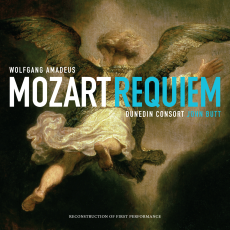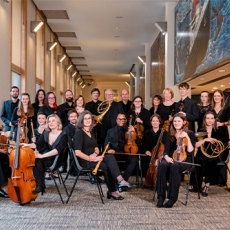Dunedin Consort - Mozart: Requiem - SA-CD.net
It is well-known that in 1791 Mozart was commissioned to
compose a Requiem for the deceased wife of Count Franz von Walsegg (the Count
had a habit of obtaining pieces from well-known composers and had them
performed under his own name in his domicile). Mozart was fully occupied at the
time with opera, so [he] only began work on the Requiem towards the end of the
year. Fatal illness overtook Mozart after he had written around two-thirds of
the work's musical material. He died after composing eight bars of the
Requiem's Lacrimosa.
Mozart's
widow Constanza needed to have the fee for the Requiem, and sought help from
several musical associates of her husband. She finally chose Franz Xaver
Süssmayr, who had worked with Mozart as a copyist and was well-versed in his
idiom, to complete the Requiem within 100 days. In the Nineteenth Century,
musicologists debated about how much the completion of the Requiem was
attributable to Süssmayr (or even to other shadowy figures). However, the
listening public was more than happy to regard the realisation of the Requiem
in d minor as the work of Süssmayr.
Around
the turn of the Twentieth Century, some musical scholars began to wonder if
contemporary composers could do a better job than Süssmayr (an example of
hubris?). The
listening public, however, retained their affinities with Süssmayr's version as
THE Mozart Requiem.
Along
comes John Butt OBE FBA FRSE with a splendid project to reconstruct the first
full performance of the Requiem, based on evidence from his own research and
that of David Black, who has produced a new edition of the Süssmayr version
which shows very clearly the areas completed by Mozart and the precise extent
of Süssmayr's additions. It also presents several details previously obscured
by later ‘improvements', particularly those added in the first published
edition by Breitkopf & Härtel in 1800 (which does not mention Süssmayr), As
an expert of choral music in Classical Vienna, Black has also collaborated with
Butt in tracing the earliest performances of the Requiem and the forces which
performed them.
It is
generally supposed that Franz Count von Walsegg, presenting a Mass in memory of
his wife at a church in Wiener Neustadt on 14 December 1793, gave the first
full performance. However, there were two previous performances. The first was
at a Requiem Mass held for Mozart in St Michael's Church on 10 December 1791
five days after his death. It seems to have been arranged by the impresario,
librettist and actor, Emanuel Schikaneder, who was a partner with Mozart on
producing 'Die Zauberflöte' Evidence suggested to Butt that only Mozart's
"finished" sections were performed (Introit and Kyrie), with a chorus
of 8 (including soloists, who also joined in with the ripienists) and single
wind and single lower strings with doubled violins. Butt adds an appendix of such
accoutred performances by the Dunedin Consort (with period instruments) in the
last two tracks of this disc.
The
second performance was the première of the whole Mozart-Süssmayr version,
presented in Vienna on 2 January 1793, just over a year after the composer's
death. This was at a well-documented benefit concert for Mozart's widow,
Constanze, which his great friend and patron, Baron Gottfried van Swieten,
promoted at a hall connected to a prestigious restaurant. Mozart's Handel
performances of just a few
years previously offer a fairly consistent picture of the type and size of the
performing group likely involved and adopted here by Butt. Four singers to each
part are included and led by the respective soloists. Strings were 6,5,4,3,2
with 2 each of Corno di Basseto, Bassoon and Trumpet, 3 Trombones, Timpani and
a Fortepiano as there was no organ in the hall. The fortepiano continuo is
reticent in Linn's sound-mixes but it clearly can be heard in the last bar of
'Rex tremendae'.
Butt's
relatively small chorus very clearly lets the orchestral be heard in more
detail than in many other performances, and the presence of the soloists
singing both ripieno and solo parts gives an intriguing texture as the solo
voices lead throughout, giving a sense of urgency. Butt's fine essay in the
disc's booklet also discusses the 'Misericordias Domini, K. 222', written by
Mozart in 1791 shortly beyond his death, which demonstrates the many styles and
influences which the composer masterfully combined to give his special musical
character to his sacred music. A fine performance of K. 222 is also added as an
appendix track on the disc, where you may also marvel at how closely Mozart's
second subject melody came to being that of Beethoven's "Ode to Joy"!
It is
extremely difficult to bring a fresh approach to such established war-horses as
Mozart's Requiem, despite the musicalogical errors of some Süssmayr additions.
However, Butt and his Dunedin Consort have done this before with their Baroque
revivals, and their superb musicianship once more produces a thrilling
performance of the Mozart-Süssmayr's version in its pristine state. The result
is a powerful affirmation of Mozart's dramatic, even heroic, consolatory
approach to Death, which surely needs no insertions or manipulations by modern
composers to make its profound effect.
Linn
recorded the Dunedin Consort in the Greyfriar's Church in Edinburgh, a venue
often used in the Edinburgh Festival and whose acoustic is very familiar to me.
The booklet has several coloured photographs showing the disposition of chorus
(soloists positioned within the whole choral group), instruments and
microphones) which are vividly recreated sonically, especially in multichannel.
The resonance of Greyfriars Kirk is beautifully caught, even to the characteristically
somewhat hollow sound at the end of dying sound when the musicians stop.
There
is no doubt that this issue is thought-provoking in its scholarship, exciting
in its spontaneous and assured musicianship and another great success for Butt
and the Dunedin Consort. This unique account of Mozart's Requiem is in the top
echelon of recordings to my ears, and I urge Mozart-lovers to acquire it
forthwith. The affection of generations of listeners for the Mozart-Süssmayr
Requiem is hereby vindicated.

